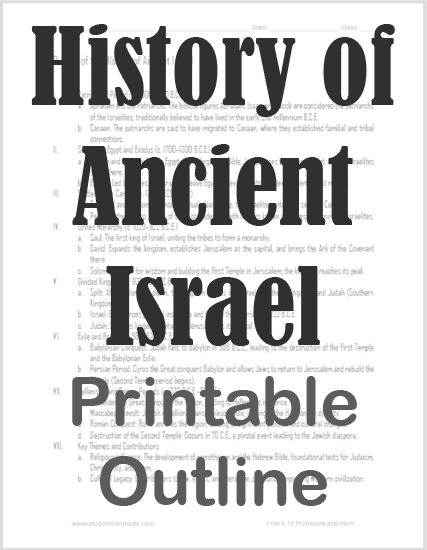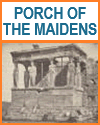| History of the Ancient Hebrews |
| www.studenthandouts.com > World History > Ancient Israel > Ancient Israel Outlines & PowerPoints |
|
This outline highlights the key events and themes in ancient Israel's history, emphasizing its significant religious and cultural contributions to world history.
Click here to print. Click here for an alternate "note-taking" version which removes the text after each colon and replaces it with added blank space. With this option, teachers can display version one on a screen, as students use the blank space on their print copies of version two to copy notes. Requiring students to "write it down" is the tried-and-true method of ensuring memory retention while keeping students engaged, with their hands and minds occupied during class. |
 |
 |
|---|
|
The history of ancient Israel is a complex and fascinating narrative, spanning several millennia and marked by significant religious, cultural, and political developments. Educators should keep in mind that there is lively debate among historians and archaeologists regarding the origins of the Hebrews, particularly on whether they arose within or without Canaan. Today's historians and archaeologists are in agreement that the Hebrews were not enslaved in Egypt; that, in fact, ancient Egypt's pyramids and temples were not built by slave labor. However, there was settlement of traders from the Levant in the Nile Delta, a fact which did turn sour at times. The return of such a group to the Levant, a group whose members went on to become part of the Hebrew religious-cultural group, could be the basis for the Exodus story. Delving into these topics can be daunting for teachers, considering the religious and political implications, especially in public schools. Outside of religious homeschools and parochial schools, most teachers opt to cover these topics lightly, approaching the biblical accounts as such--religious stories crucial to Jewish history and identity—but which scholars of many faiths (including Jewish researchers) believe to be myth. The consensus is that the Hebrews developed as an self-identified religious group in Canaan around the fall of the Bronze Age (around 1200 B.C.E.). This was roughly the same time period that saw a group of Bronze Age collapse refugees—possibly Sea Peoples and possibly from Crete—called the Peleset by the Egyptians—granted permission by pharaoh to settle in the region known as Gaza. It is from these people that we get the placename (toponym) Palestine; the Bible calls these people Philistines. The above described level of detail is atypical for the standard scope and sequence of high school World History courses. But given the ongoing political climate over circumstances in today's Israel, teachers should be prepared to address this ancient history in the event of student questions. |
|
I. Patriarchal Period (circa 2000–1500 B.C.E.) a. Abraham and the Patriarchs: The biblical figures Abraham, Isaac, and Jacob are considered the patriarchs of the Israelites, traditionally believed to have lived in the early 2nd millennium B.C.E. b. Canaan: The patriarchs are said to have migrated to Canaan, where they established familial and tribal connections. II. Sojourn in Egypt and Exodus (circa 1700–1300 B.C.E.) a. Joseph and the Israelites in Egypt: According to the Bible, Joseph rises to power in Egypt, and the Israelites settle there. b. Exodus: Led by Moses, the Israelites leave Egypt, an event central to Jewish identity and religion. III. Settlement in Canaan (circa 1300–1020 B.C.E.) a. Conquest and Settlement: Under Joshua's leadership, the Israelites enter and settle in Canaan. b. Period of the Judges: A time of tribal confederacy, with leaders known as judges governing the Israelites. IV. United Monarchy (circa 1020–922 B.C.E.) a. Saul: The first king of Israel, uniting the tribes to form a monarchy. b. David: Expands the kingdom, establishes Jerusalem as the capital, and brings the Ark of the Covenant there. c. Solomon: Known for wisdom and building the First Temple in Jerusalem; the kingdom reaches its peak. V. Divided Kingdom (circa 922–722 B.C.E.) a. Split: After Solomon’s death, the kingdom divides into Israel (Northern Kingdom) and Judah (Southern Kingdom). b. Israel: Experiences political instability and falls to the Assyrians in 722 B.C.E. c. Judah: Survives longer, maintaining Jerusalem as its capital. VI. Exile and Return (circa 586–539 B.C.E.) a. Babylonian Conquest: Judah falls to Babylon in 586 B.C.E., leading to the destruction of the First Temple and the Babylonian Exile. b. Persian Period: Cyrus the Great conquers Babylon and allows Jews to return to Jerusalem and rebuild the Temple (Second Temple period begins). VII. Hellenistic and Roman Periods (circa 332 B.C.E.–70 C.E.) a. Alexander the Great: Conquers the region, leading to Hellenistic influence. b. Maccabean Revolt: Jewish rebellion against Seleucid rule, leading to the Hasmonean dynasty. c. Roman Conquest: Rome annexes the region, leading to significant political and cultural changes. d. Destruction of the Second Temple: Occurs in 70 C.E., a pivotal event leading to the Jewish diaspora. VIII. Key Themes and Contributions a. Religious Influence: The development of monotheism and the Hebrew Bible, foundational texts for Judaism, Christianity, and Islam. b. Cultural Legacy: Contributions to law, ethics, and literature, profoundly impacting Western civilization. |
| Ancient Israel Books and Films | Ancient Israel Outlines and PowerPoints |
| Ancient Israel Maps and Pictures | Ancient Israel Study Games |
| Ancient Israel Miscellany | Ancient Israel Worksheets |
| www.studenthandouts.com > World History > Ancient Israel > Ancient Israel Outlines & PowerPoints |









